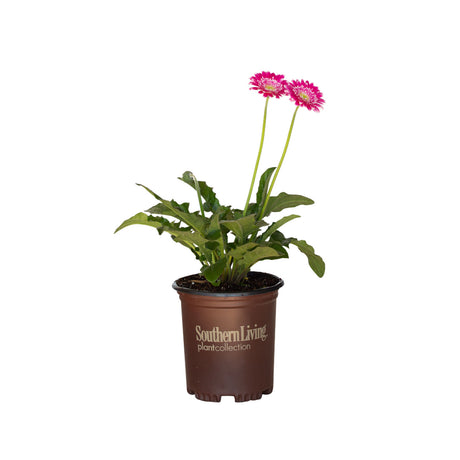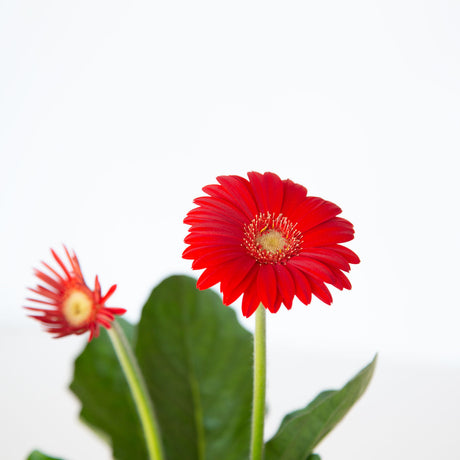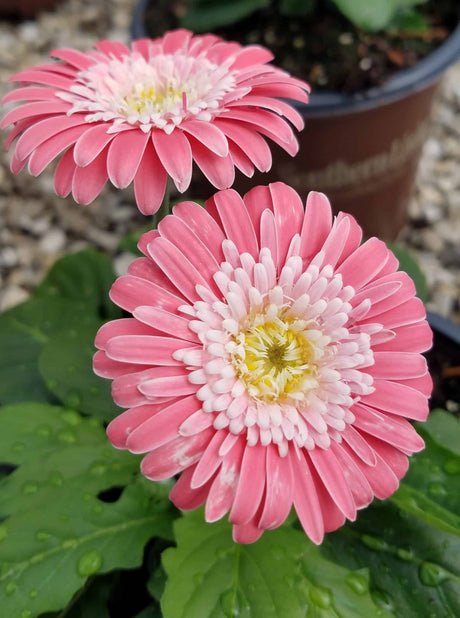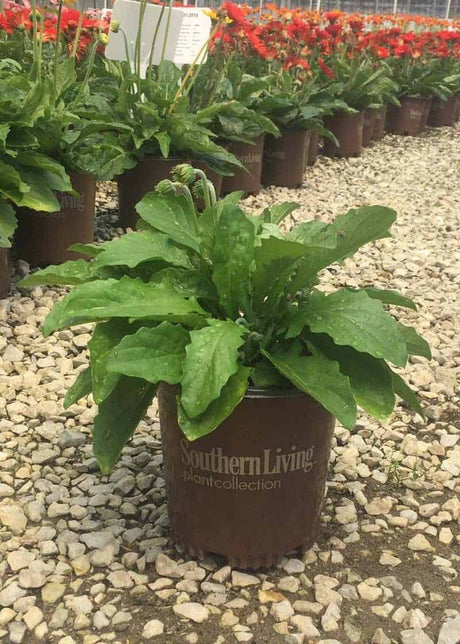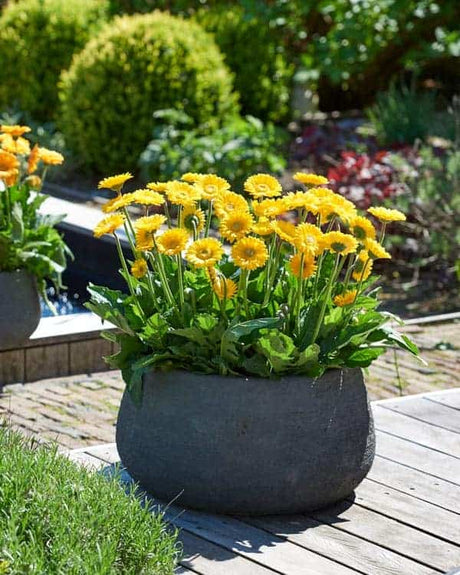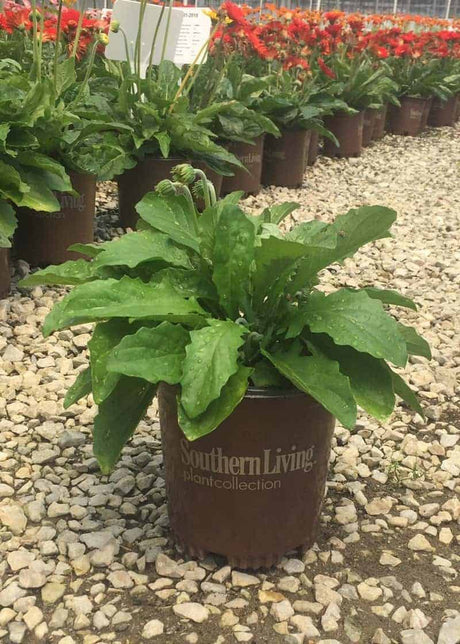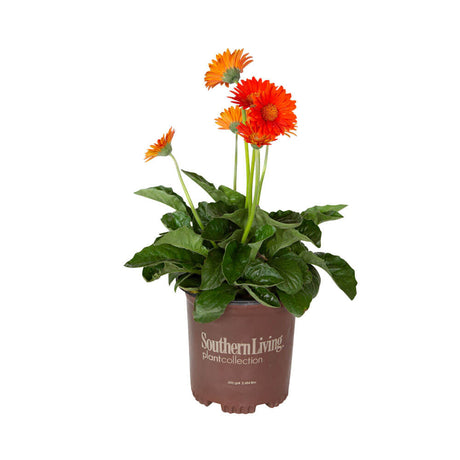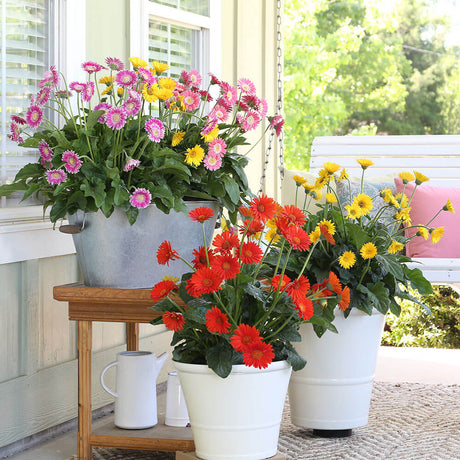FiltersFilter & Sort
- Sold out
Southern Living Plant Collection
Frosted Hot Pink Garden Jewels™ Gerbera Daisy
$18.99Unit price /Unavailable - Sold out
- Sold out
- Sold out
- Sold out
When it comes to steady bloomers, the Gerbera Daisy is, hands down, one of the steadiest perennials around.
What is a Gerbera Daisy?
Gerbera Daisies, also known as Transvaal Daisies, were initially brought over from South Africa. Scottish naturalist and mineralogist Robert Jameson first cataloged them in 1884 near Barberton. As you might expect, the naturally occurring Daisies that Jameson experienced were quite different from those we know and love today. However, breeding programs began towards the end of the 19th century that cultivated these perennials to develop different colors and flower forms that look more familiar today. Through the years, they've only increased in popularity. They're one of the most popular flowers in the entire world! They rank fifth behind several common favorites, namely Roses, Carnations, Chrysanthemums, and Tulips.
Why Should I Plant Them?
This is an easy question, fortunately.
New varieties of Gerbera Daisy are hardier than ever
Over the years, Gerbera Daisies have developed a slight reputation as being very difficult to keep alive. This is because they were finely tuned to survive in South Africa, not the United States. Someone would pick up a pretty little plant at the grocery store and try their best to keep it alive without success. However, we here at PlantsbyMail.com specifically do not carry the classic Gerbera jamesonii varieties for this very reason. We carry hybrid varieties, primarily from the Garden Jewels series from the Southern Living Plant Collection. These are far hardier than traditional breeds, and they have some of the most stunning blooms you could ever imagine. They'll exceed your expectations and prove perennial for gardeners in USDA Zones 7-10.
They bloom and bloom and bloom
Provided that they're experiencing favorable planting conditions and weather, these treasures always seem to be in bloom. A mature specimen will send up around 100 flowers over the growing season. Each flower just as gorgeous as the next.
They come in a huge variety of colors
Crimson, dark red, blush pink, white, hot pink, orange, coral, yellow, and bicolor to name some of our favorites. You'll certainly be able to find one or a few that you can't get enough of. One of our favorite ways to use them is to plant several different colors about a foot apart in a garden bed. They'll grow together beautifully and send up a symphony of flowers in different colors throughout the year that is truly just breathtaking. Also, try mixing them with other perennial bloomers, like Agapanthus.
Where Should They Be Planted?
They should be planted in a location where they will receive Full Sun to Partial Sun exposure. 3-6 hours of direct sunlight tends to be ideal for them. They'll bloom more if they receive more sun and have more dense foliage. However, we do recommend gardeners in USDA Zones 9 & 10 avoid all-day sun which can prove stressful for them in these hotter areas. If you do attempt to grow them in these conditions, ensure that they aren't drying out rapidly during the summer. Plant them in rich garden soil to ensure that they have the nutrients that they need to grow and flower. It's not a bad idea to supplement your soil with some compost either. They need good drainage in order to avoid root rot, which they can fall victim to in standing water or overwatering situations. Generally, they only need water 2-3 times per week during the first growing season. They may require more during the summer heat, though.
When is the Best Time to Plant Gerbera Daisies?
This will often depend on where you are located. New plantings are much more vulnerable to harsh weather conditions than established plants. Therefore, early fall and mid-spring are traditionally considered the two most ideal times to plant. During these two periods, they will be temporarily safe from consistently extreme temperatures. For USDA Zones 7 to 8: Mid-Spring is generally a better time to plant Gerbera Daisies for these zones. It gives them more time to establish themselves over the year which allows them to be more prepared to deal with the winter cold. We still recommend covering first-year plantings overnight with some sort of blanket or freeze cloth to help ensure your plant's survival. For USDA Zones 9 to 10: In hotter zones, we recommend planting in early fall. These two zones don't experience much in the way of freezing temperatures, so you don't have to worry about your new plants being prepared for extreme cold as much. This way they're able to establish themselves before the intense summer heat sets in.
How Do I Plant Them?
- Find a suitable planting location for your new plant(s).
- Remember to leave a little room for them to spread out over time, at least a foot between each plant.
- Dig a hole three times as wide as the pot that your plants came in.
- Don’t dig the hole any deeper than what allows for your plant to sit evenly with the ground around it. If you have slow-draining soil, dig a slightly shallower hole so your plant will sit a couple of inches above the soil around it. Mound the soil around the base of the plant.
- Mix your native soil with some rich garden soil or compost to enrich the ground and encourage healthy growth and expansion.
- Place the plant in the hole and backfill around it with your dirt mixture. Gently tamp down the newly laid soil.
- Laying mulch at this point will help your plant retain more moisture and prevent it from drying out too rapidly.
- Water your new planting heartily to help settle the soil, as well as hydrate your plant.
- Now is a good time for a light fertilizer application. If you’re planting in mid to late fall or summer, use a root rocket fertilizer. If you’re planting in spring or early fall, use a slow-release balanced plant fertilizer. We don’t recommend using liquid fertilizer on new plantings.
Why Should You Order Gerbera Daisies from Us?
We love our plants and we love our customers. It's our job to pick happy and healthy plants that are ready to thrive in your landscape and then send them safely and securely on their way to you. All of our plants are shipped in pots with soil, never bare-root. If you have an issue with your order, contact us and let us know right away. Either call us at 1-866-618-5659 or email us at info@plantsbymail.com. We'll be sure to get back to you as soon as possible and do whatever we can to make it right.

